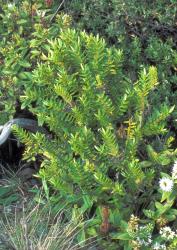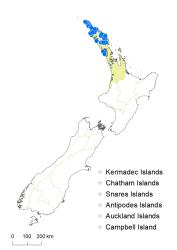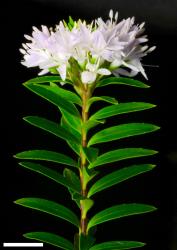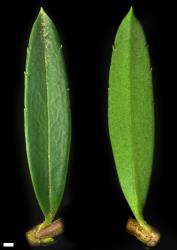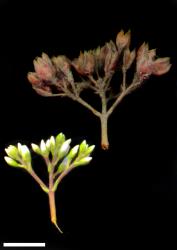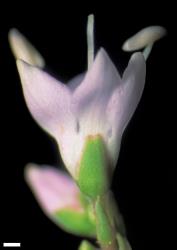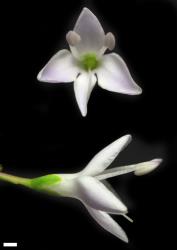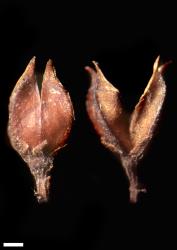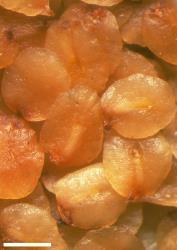- Taxon
- Gallery
- ≡ Hebe diosmifolia (A.Cunn.) Andersen, Trans. New Zealand Inst. 56: 693 (1926)
- = Veronica menziesii Benth. in de Candolle, Prodr. 10 461 (1846)
- ≡ Hebe menziesii (Benth.) Cockayne & Allan, Trans. New Zealand Inst. 57: 25 (1926)
- = Veronica trisepala Colenso, Trans. New Zealand Inst. 15: 324 (1883)
- ≡ Veronica diosmifolia var. trisepala (Colenso) Kirk, Trans. New Zealand Inst. 28: 525 (1896)
- ≡ Hebe diosmifolia var. trisepala (Colenso) A.Wall, Trans. & Proc. New Zealand Inst. 60: 384 (1929)
- = Hebe diosmifolia var. vernalis Carse, Trans. New Zealand Inst. 60: 306 (1929)
Bushy shrub to 2.5 m tall, or occasionally small tree to 6 m tall. Stems erect or spreading, eglandular-pubescent; hairs uniform or tending bifarious. Leaf bud distinct, leaves appressed at margins until fully grown; sinus narrowly to broadly acute. Leaves sub-distichous, spreading; lamina sub-coriaceous to rigid, narrowly oblong-elliptic to oblong to linear-lanceolate, 8–30 mm long, 3–6 mm wide, rarely smaller, dull, green to dark green above, pale green beneath; midrib evident and faint lateral veins sometimes evident; surfaces glabrous or with eglandular hairs along midrib above; margin glabrous or glandular- and/or eglandular-ciliolate, especially when young, bevelled, crenulate or papillate, entire or shallowly incised or shallowly serrate; teeth in 0–6 pairs; apex obtuse to acute or acuminate, plicate-mucronate; base cuneate; petiole 0.3–4.0 mm long. Inflorescence a lateral ternate to compound or rarely simple raceme, 10–55 mm long; flowers crowded, 4–54, all bisexual; bracts opposite-decussate, or becoming alternate above, lanceolate to broadly ovate, ≤ pedicels; pedicels erecto-patent, 1.5–4.2 mm long, eglandular-hairy all around. Calyx lobes 4–5 (5th lobe small, posterior; anterior lobes free or partly to completely connate, obtuse to sub-acute, 1.3–2.0 mm long, sub-equal, mixed glandular- and eglandular-ciliolate. Corolla 8–11 mm diameter, tube white, 2.0–2.5 mm long, ≥ calyx, glabrous; lobes 4, white, pink, purplish or bluish, erecto-patent to spreading, sub-equal, lanceolate to ovate to deltoid, 3–6 mm long, sub-acute to acute; nectar guides absent. Stamen filaments white, 4–6 mm long; anthers white to pale purplish. Style glabrous, 5.5–8.5 mm long. Capsules latiseptate, sub-acute to acute, glabrous, 3.5–5.4 mm long, 1.8–3.7 mm at widest point. Seeds ellipsoid, ovoid, obovoid, or discoid, flattened, smooth, straw-yellow to pale brown, 1.2–2.0 mm long.
Veronica diosmifolia plants can be distinguished from other hebes that grow with it in northern New Zealand by its small, darker green, often toothed leaves, narrow, acute sinus, and compound racemes.
V. diosmifolia plants are similar to V. subfulvida; both are large shrubs with narrow leaves, a narrow sinus in the bud, and clusters of compound racemes near the tips of the shoots. They have widely separate distributions: V. diosmifolia in the North Island north of about Helensville; V. subfulvida in the South Island north of Lake Rotoiti. Also, V. subfulvida has the anterior calyx lobes free (fused in at least some flowers on every plant) and the leaves never toothed (often toothed in V. diosmifolia). Plants of V. venustula and V. brachysiphon, again distributed much further south, have a similar form of narrow, acute sinus, but differ in having free calyx lobes, longer corolla tubes, usually simple racemose inflorescences, and entire leaves.
North Island: Northland, Auckland (west of Kaipara Harbour).
A specimen said to be from the Kaweka Range, Hawke’s Bay, is not included in the accepted distribution, following Bayly & Kellow (2006).
Lowland scrub, forest margins, often near the coast or along river banks. Recorded elevations range from 0 to 274 m.
Veronica ‘Spring Monarch’ and V. ‘Waikanae’ are believed to be artificial hybrids between V. diosmifolia and V. hulkeana (Garnock-Jones 2008).
Flowers: all year round but mostly September–January; fruits: all year but mostly October–May.
2n = 40, 80 (see Bayly & Kellow 2006, as Hebe diosmifolia).
Veronica diosmifolia is classified in V. subg. Pseudoveronica sect. Hebe and the informal group “Apertae” (small-leaved) (Albach & Meudt 2010; Bayly & Kellow 2006).
There is variation within the species in chromosome number, flowering times (var. vernalis was based on spring-flowering plants), and the fusion of the anterior pair of calyx lobes (var. trisepala was based on plants with fused lobes), yet these differences were not found to be correlated (Murray et al. 1989). Tetraploid plants were all found in northern populations, but there is overlap in the distribution of tetraploid and diploid cytotypes. Bayly & Kellow (2006) and Murray et al. (1989) concluded that no taxonomic division within V. diosmifolia (as Hebe diosmifolia) could be justified.
Cultivars
Veronica diosmifolia ‘Wairua Beauty’ is widely cultivated.



